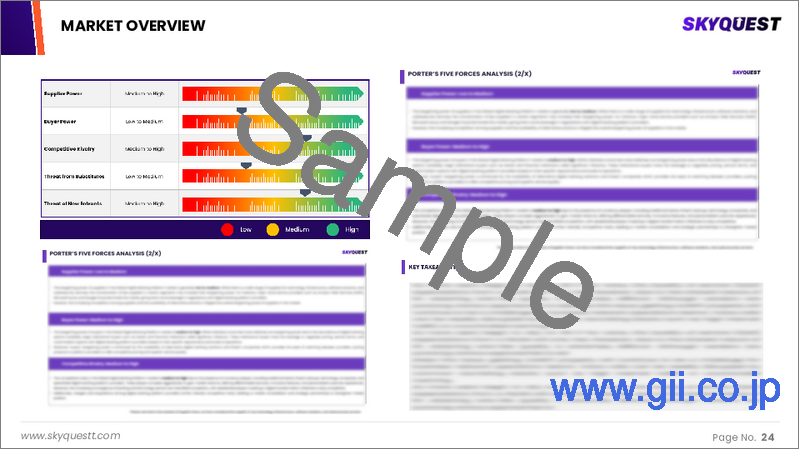|
|
市場調査レポート
商品コード
1780216
マネージドITインフラサービス市場規模、シェア、成長分析、タイプ別、エンドユーザー別、企業規模別、サービスカテゴリー別、地域別 - 産業予測、2025年~2032年Managed IT Infrastructure Services Market Size, Share, and Growth Analysis, By Type (On-premises, Cloud), By End User (IT and Telecommunications, BFSI), By Enterprises Size, By Service Category, By Region - Industry Forecast 2025-2032 |
||||||
|
|||||||
| マネージドITインフラサービス市場規模、シェア、成長分析、タイプ別、エンドユーザー別、企業規模別、サービスカテゴリー別、地域別 - 産業予測、2025年~2032年 |
|
出版日: 2025年07月26日
発行: SkyQuest
ページ情報: 英文 171 Pages
納期: 3~5営業日
|
全表示
- 概要
- 目次
マネージドITインフラサービスの世界市場規模は、2023年に1,205億米ドルと評価され、2024年の1,319億5,000万米ドルから2032年には2,727億2,000万米ドルに成長し、予測期間(2025年~2032年)のCAGRは9.5%で成長する見通しです。
世界のマネージドITインフラサービス市場は、クラウドベースのマネージドセキュリティソリューションに対する需要の高まり、コアビジネス機能の重視、IT環境の複雑化などが大きな要因となって、力強い成長を遂げています。デジタルトランスフォーメーションの進行とサイバーセキュリティへの関心の高まりは、この市場拡大をさらに加速させ、さまざまな業界がダウンタイムを最小限に抑え、生産性を向上させながら、主要な目標に集中できるようにします。技術の進歩は市場に大きな影響を与え、人的ミスの削減、リソースの節約、ITシステムパフォーマンスの最適化を目的とした革新的なマネージドサービスが提供されています。デジタルモデルの導入が進む中、企業は24時間体制のITサポートを提供するだけでなく、効率的な運用環境でユーザーデータの安全な管理を保証するマネージドサービスソリューションを求めています。
目次
イントロダクション
- 調査の目的
- 調査範囲
- 定義
調査手法
- 情報調達
- 二次と一次データの方法
- 市場規模予測
- 市場の前提条件と制限
エグゼクティブサマリー
- 世界市場の見通し
- 供給と需要の動向分析
- セグメント別機会分析
市場力学と見通し
- 市場概要
- 市場規模
- 市場力学
- 促進要因と機会
- 抑制要因と課題
- ポーターの分析
主な市場の考察
- 重要成功要因
- 競合の程度
- 主な投資機会
- 市場エコシステム
- 市場の魅力指数(2024年)
- PESTEL分析
- マクロ経済指標
- バリューチェーン分析
- 価格分析
- 技術分析
- ケーススタディ
- 顧客購買行動分析
マネージドITインフラサービス市場規模:タイプ別& CAGR(2025-2032)
- 市場概要
- オンプレミス
- クラウド
マネージドITインフラサービス市場規模:エンドユーザー別& CAGR(2025-2032)
- 市場概要
- IT・通信
- BFSI
- ヘルスケア
- 製造業
- 運輸・物流
- 小売り
- その他のエンドユーザー
マネージドITインフラサービス市場規模:企業規模別& CAGR(2025-2032)
- 市場概要
- 中小企業
- 大企業
マネージドITインフラサービス市場規模:サービスカテゴリー別& CAGR(2025-2032)
- 市場概要
- 仮想化
- ネットワーキング
- ストレージ
- サーバー
マネージドITインフラサービス市場規模:地域別& CAGR(2025-2032)
- 北米
- 米国
- カナダ
- 欧州
- ドイツ
- スペイン
- フランス
- 英国
- イタリア
- その他欧州地域
- アジア太平洋地域
- 中国
- インド
- 日本
- 韓国
- その他アジア太平洋地域
- ラテンアメリカ
- ブラジル
- その他ラテンアメリカ地域
- 中東・アフリカ
- GCC諸国
- 南アフリカ
- その他中東・アフリカ
競合情報
- 上位5社の比較
- 主要企業の市場ポジショニング(2024年)
- 主な市場企業が採用した戦略
- 最近の市場動向
- 企業の市場シェア分析(2024年)
- 主要企業の企業プロファイル
- 企業の詳細
- 製品ポートフォリオ分析
- 企業のセグメント別シェア分析
- 収益の前年比比較(2022-2024年)
主要企業プロファイル
- Accenture Plc
- Fujitsu Limited
- Lenovo Group Limited
- Cisco Systems Inc.
- Dell Technologies Inc.
- Happiest Minds Technologies
- DXC Technology Corporation
- Hewlett Packard Enterprise
- Telefonaktiebolaget LM Ericsson
- CSS Corp Pvt Ltd.
- IBM Corporation
- Microsoft Corporation
- Verizon Communications Inc.
- Citrix Systems Inc.
- Tata Consultancy Services Limited
- Deutsche Telekom AG
結論と提言
Global Managed IT Infrastructure Services Market size was valued at USD 120.5 billion in 2023 and is poised to grow from USD 131.95 billion in 2024 to USD 272.72 billion by 2032, growing at a CAGR of 9.5% during the forecast period (2025-2032).
The global managed IT infrastructure services market is witnessing robust growth, largely fueled by escalating demand for cloud-based managed security solutions, an emphasis on core business functions, and the increasing complexity of IT environments. The ongoing digital transformation and heightened cybersecurity concerns further accelerate this expansion, allowing various industries to concentrate on their primary objectives while minimizing downtime and enhancing productivity. Technological advancements significantly influence the market, with innovative managed service offerings aimed at reducing human error, conserving resources, and optimizing IT system performance. As organizations increasingly adopt digital models, they seek managed service solutions that not only provide round-the-clock IT support but also ensure secure management of user data in efficient operational settings.
Top-down and bottom-up approaches were used to estimate and validate the size of the Global Managed IT Infrastructure Services market and to estimate the size of various other dependent submarkets. The research methodology used to estimate the market size includes the following details: The key players in the market were identified through secondary research, and their market shares in the respective regions were determined through primary and secondary research. This entire procedure includes the study of the annual and financial reports of the top market players and extensive interviews for key insights from industry leaders such as CEOs, VPs, directors, and marketing executives. All percentage shares split, and breakdowns were determined using secondary sources and verified through Primary sources. All possible parameters that affect the markets covered in this research study have been accounted for, viewed in extensive detail, verified through primary research, and analyzed to get the final quantitative and qualitative data.
Global Managed IT Infrastructure Services Market Segments Analysis
Global Managed IT Infrastructure Services Market is segmented by Type, End User, Enterprises Size, Service Category and region. Based on Type, the market is segmented into On-premises and Cloud. Based on End User, the market is segmented into IT and Telecommunications, BFSI, Healthcare, Manufacturing, Transportation & Logistics, Retail and Other End-Users. Based on Enterprises Size, the market is segmented into Small & Medium Enterprises and Large Enterprises. Based on Service Category, the market is segmented into Virtualization, Networking, Storage and Servers. Based on region, the market is segmented into North America, Europe, Asia Pacific, Latin America and Middle East & Africa.
Driver of the Global Managed IT Infrastructure Services Market
The rising expenses associated with managing internal IT infrastructure can be a significant burden for organizations. By utilizing managed IT infrastructure services, businesses can effectively reduce these costs while benefiting from expert management, monitoring, and maintenance of their systems at a competitive price. These services provide robust protection against expensive downtime, while also minimizing the financial strain of investing in costly hardware and software, as well as the necessity of hiring on-site personnel. Consequently, such advantages contribute substantially to the expansion of the global managed IT infrastructure services market, offering a strategic and economical solution for diverse organizations.
Restraints in the Global Managed IT Infrastructure Services Market
A significant challenge faced by the Global Managed IT Infrastructure Services market is the reluctance of numerous businesses to share sensitive information with third-party service providers. Despite the fact that many managed IT service companies implement strong security measures, businesses harbor concerns about data breaches, hacking incidents, and the potential erosion of control over their data and its integrity. This caution is particularly pronounced among companies operating in regulated sectors such as healthcare and finance, where the safeguarding of private data is paramount, leading to increased hesitance in engaging with external providers for IT infrastructure support.
Market Trends of the Global Managed IT Infrastructure Services Market
The Global Managed IT Infrastructure Services market is witnessing a notable trend driven by the escalating emphasis on cybersecurity. As cyber threats grow increasingly complex and prevalent, organizations are prioritizing security, prompting managed IT service providers to enhance their offerings with specialized security capabilities. This includes continuous threat monitoring, advanced detection, and real-time response and remediation for attacks. By leveraging managed services, businesses not only fortify their defenses against cyber threats but also ensure compliance with stringent regulatory requirements. This trend ultimately aids in minimizing redundancies in risk management, thus fostering a proactive IT infrastructure landscape.
Table of Contents
Introduction
- Objectives of the Study
- Scope of the Report
- Definitions
Research Methodology
- Information Procurement
- Secondary & Primary Data Methods
- Market Size Estimation
- Market Assumptions & Limitations
Executive Summary
- Global Market Outlook
- Supply & Demand Trend Analysis
- Segmental Opportunity Analysis
Market Dynamics & Outlook
- Market Overview
- Market Size
- Market Dynamics
- Drivers & Opportunities
- Restraints & Challenges
- Porters Analysis
- Competitive rivalry
- Threat of substitute
- Bargaining power of buyers
- Threat of new entrants
- Bargaining power of suppliers
Key Market Insights
- Key Success Factors
- Degree of Competition
- Top Investment Pockets
- Market Ecosystem
- Market Attractiveness Index, 2024
- PESTEL Analysis
- Macro-Economic Indicators
- Value Chain Analysis
- Pricing Analysis
- Technology Analysis
- Case Studies
- Customer Buying Behavior Analysis
Global Managed IT Infrastructure Services Market Size by Type & CAGR (2025-2032)
- Market Overview
- On-premises
- Cloud
Global Managed IT Infrastructure Services Market Size by End User & CAGR (2025-2032)
- Market Overview
- IT and Telecommunications
- BFSI
- Healthcare
- Manufacturing
- Transportation & Logistics
- Retail
- Other End-Users
Global Managed IT Infrastructure Services Market Size by Enterprises Size & CAGR (2025-2032)
- Market Overview
- Small & Medium Enterprises
- Large Enterprises
Global Managed IT Infrastructure Services Market Size by Service Category & CAGR (2025-2032)
- Market Overview
- Virtualization
- Networking
- Storage
- Servers
Global Managed IT Infrastructure Services Market Size & CAGR (2025-2032)
- North America (Type, End User, Enterprises Size, Service Category)
- US
- Canada
- Europe (Type, End User, Enterprises Size, Service Category)
- Germany
- Spain
- France
- UK
- Italy
- Rest of Europe
- Asia Pacific (Type, End User, Enterprises Size, Service Category)
- China
- India
- Japan
- South Korea
- Rest of Asia-Pacific
- Latin America (Type, End User, Enterprises Size, Service Category)
- Brazil
- Rest of Latin America
- Middle East & Africa (Type, End User, Enterprises Size, Service Category)
- GCC Countries
- South Africa
- Rest of Middle East & Africa
Competitive Intelligence
- Top 5 Player Comparison
- Market Positioning of Key Players, 2024
- Strategies Adopted by Key Market Players
- Recent Developments in the Market
- Company Market Share Analysis, 2024
- Company Profiles of All Key Players
- Company Details
- Product Portfolio Analysis
- Company's Segmental Share Analysis
- Revenue Y-O-Y Comparison (2022-2024)
Key Company Profiles
- Accenture Plc
- Company Overview
- Business Segment Overview
- Financial Updates
- Key Developments
- Fujitsu Limited
- Company Overview
- Business Segment Overview
- Financial Updates
- Key Developments
- Lenovo Group Limited
- Company Overview
- Business Segment Overview
- Financial Updates
- Key Developments
- Cisco Systems Inc.
- Company Overview
- Business Segment Overview
- Financial Updates
- Key Developments
- Dell Technologies Inc.
- Company Overview
- Business Segment Overview
- Financial Updates
- Key Developments
- Happiest Minds Technologies
- Company Overview
- Business Segment Overview
- Financial Updates
- Key Developments
- DXC Technology Corporation
- Company Overview
- Business Segment Overview
- Financial Updates
- Key Developments
- Hewlett Packard Enterprise
- Company Overview
- Business Segment Overview
- Financial Updates
- Key Developments
- Telefonaktiebolaget LM Ericsson
- Company Overview
- Business Segment Overview
- Financial Updates
- Key Developments
- CSS Corp Pvt Ltd.
- Company Overview
- Business Segment Overview
- Financial Updates
- Key Developments
- IBM Corporation
- Company Overview
- Business Segment Overview
- Financial Updates
- Key Developments
- Microsoft Corporation
- Company Overview
- Business Segment Overview
- Financial Updates
- Key Developments
- Verizon Communications Inc.
- Company Overview
- Business Segment Overview
- Financial Updates
- Key Developments
- Citrix Systems Inc.
- Company Overview
- Business Segment Overview
- Financial Updates
- Key Developments
- Tata Consultancy Services Limited
- Company Overview
- Business Segment Overview
- Financial Updates
- Key Developments
- Deutsche Telekom AG
- Company Overview
- Business Segment Overview
- Financial Updates
- Key Developments





